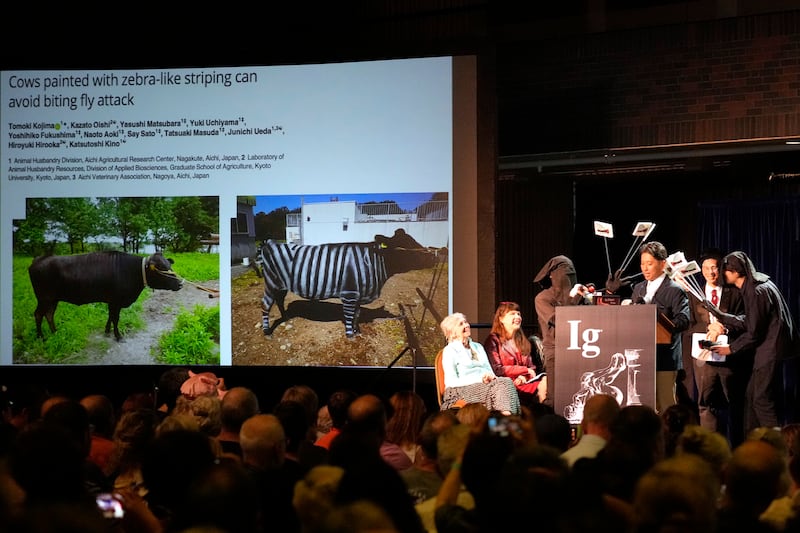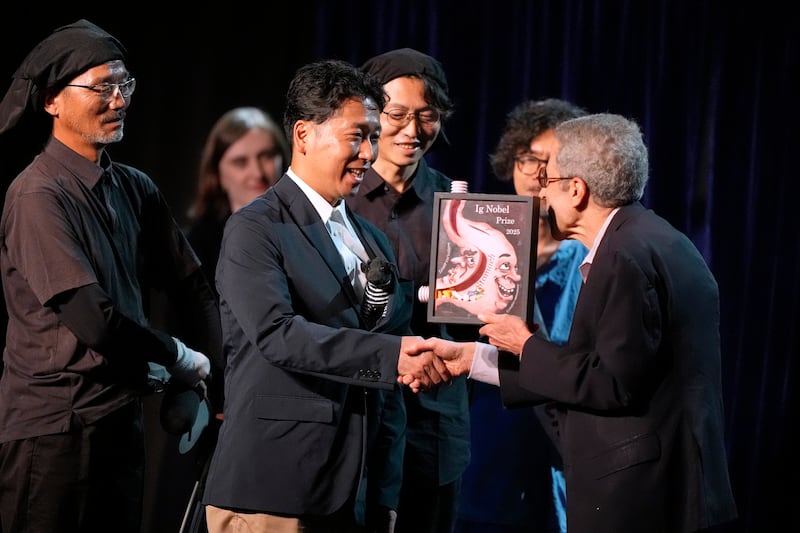- The Ig Nobel prize recognizes odd scientific research that typically challenges traditional thoughts and presumptions.
- Presented by actual Nobel Laureates, the Ig Nobel prize ceremony champions humorous elements and traditions.
- The year's nutrition prize was awarded for an investigation into the favorite pizza of rainbow lizards.
Have you ever wondered what type of pizza lizards would prefer, or if painting zebra stripes on cows would help deter flies?
Well, at least a few scientists had these questions and other similiar queries, leading them to win an Ig Nobel prize for their odd, funny and ridiculous research projects and discoveries.
The Ig Nobel prize award ceremony took place at Boston University on Thursday, according to The Associated Press.
What is an Ig Nobel prize?

The Ig Nobel Prize awards some of the “world’s brightest and quirkiest scientific minds,” recognizing them for their endeavors, per The Washington Post. The awards serve as a lighter counterpoint to the Nobel Prizes, the world renowned accolade in memory of Swedish inventor Alfred Nobel.
Nobel Prizes are focused on cutting-edge developments in physics, medicine, literature, chemistry, economic sciences and peace, but the Ig Nobels are given for scientific research that makes “people laugh and then think,” per CNN.
This year is the awards’ 35th year. The Ig Nobels are hosted by Improbable Research, a digital magazine that highlights this same type of odd research.
The awards are presented by actual Nobel laureates, and the ceremony is filled with a number of absurd elements. One long-standing tradition is the audience throwing a deluge of paper airplanes on stage, and this year’s ceremony featured a mini opera titled “The Plight of the Gastroenterologist.”
Digestion was this year’s theme, inspiring the mini opera.
“Every great discovery ever, at first glance seemed screwy and laughable,” Marc Abrahams, master of ceremonies and editor of the magazine, wrote to the AP. “The same is true of every worthless discovery. The Ig Nobel Prizes celebrate ALL these discoveries, because at the very first glance, who really knows?”
What discoveries won Ig Nobels this year?
The nutrition prize was awarded to a group of scientists for their question of what type of pizza lizards prefer. During the study, the researchers found that rainbow lizards at a resort in Togo, West Africa, have a preference for four-cheese pizza, per The Washington Post.
Tropical ecologist Luca Luiselli said his team “simply wanted to answer the age-old scientific question: What happens when a lizard discovers cheese and carbs?”
The Ig Nobel literature award was given posthumously to William B. Bean for his work “persistently recording and analyzing the rate of growth of one of his fingernails over a period of 35 years.”
A group of European scientists received the physics prize for studying the physics of pasta sauce. The goal of the study was to figure out how to stop cacio e pepe sauce from clumping.
“A true Italian grandmother or a skilled home chef from Rome would never need a scientific recipe for Cacio e pepe,” the scientists wrote, adding that the answer is in the perfect ratio of starch to cheese, per The Washington Post.
“To achieve the correct starch ratio, 5 grams of starch is optimal for 200 grams of cheese,” they said.
A pair of American and Israeli researchers earned the prize for chemistry for their study on whether eating Teflon could be used to increase food volume and help people feel full without adding extra calories.
“Civilization has zero calorie drinks but we have not yet made the leap into the realm of zero calorie foods,” the researchers noted. They added that it is an ideal way to add substance but not calories, per The Washington Post.
The psychology prize went to researchers who looked into what happens when you tell a narcissist, or anyone, that they are smart, per CNN.
Another prize was given to Dutch and German researchers for their findings that drinking alcohol can sometimes improve someone’s ability to speak a foreign language.
It was a Japanese research team that won the award in biology for experimenting on whether painting cows with zebra-like stripes can prevent them from being bitten by flies. The results showed that it can, per The Washington Post.
The pediatrics prize was given to researchers who looked into the experience of a nursing baby whose mother eats garlic, per CNN.
Another team won the aviation prize for their research looking into the effects of alcohol consumption on bats’ ability to echolocate and fly.


